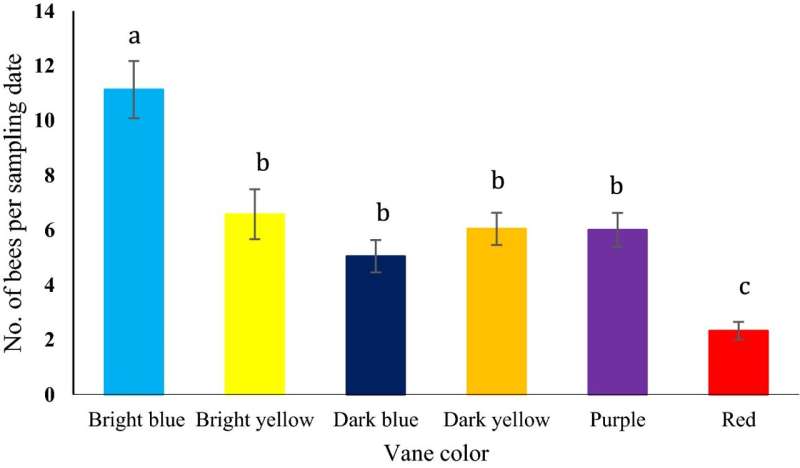This article has been reviewed according to Science X's editorial process and policies. Editors have highlighted the following attributes while ensuring the content's credibility:
fact-checked
peer-reviewed publication
trusted source
proofread
To improve surveys and other research, entomologists study how colors attract wild bees

Red means stop. Green means go. But to bees, colors reveal a smorgasbord of available food sources.
Neel Joshi, associate professor of entomology for the Arkansas Agricultural Experiment Station, the research arm of the University of Arkansas System's Division of Agriculture, said colors serve as visual cues to bees. Color helps them identify flowers from which they can collect nectar for food. For this reason, monitoring traps are often brightly colored to attract and collect bee specimens for study.
Many different types of traps are commercially available, Joshi said, and vane traps that use blue and yellow vanes to attract bees are a common device to trap them. But their effectiveness varies depending on bee species and the environment in which they are used.
Keeping count
Joshi said many research goals require trapping bees. For example, his lab is currently sampling and documenting native bee species in six ecoregions of Arkansas.
"There are about 4,000 species of wild native bees in the United States," Joshi said. "We have documented more than 200 species in Arkansas, but we think there may be as many as 400 or more native species in the state."
Most bees in Arkansas are ground-nesting and tunnel-nesting species, and they are solitary bees, Joshi said. These include small carpenter bees, sweat bees, leafcutting bees and mason bees. Some, like carpenter bees, dig their own tunnels for nests. Mason bees, like blue orchard bees, use existing tunnels cut by other insect species into trees or wooden structures.
Native bees are important pollinators, Joshi said. Along with other pollinators, including moths and butterflies, native bees benefit more than 75% of plants in Arkansas, including 35% of crop plants.
"Monitoring their abundance and diversity is necessary to develop appropriate conservation and management practices to protect them," Joshi said.
Building a better bee trap
Roshani S. Acharya, a former graduate student in Joshi's insect ecology lab, led a research project to determine which colors worked best to attract bees to vane traps. Joshi said his lab team converted commercially available vane traps by refining the design and constructing new vanes from yellow, red and blue micro prismatic material that reflects light in selected color spectrums.
"These colors reflect into the ultraviolet spectrum where bees see," Joshi said.
The research has been published in Scientific Reports.
The base material is plastic, chosen for durability and weather resistance, Joshi said. The reconfigured traps were placed in newly established livestock pastures that include pollinator-friendly native flower mixes that are frequented by wild bees.
The traps were deployed only 24 hours at a time to avoid oversampling. "We only need enough bees to identify the species," Joshi said. Care was taken to preserve as many bees alive as possible.
"We want to collect as few as possible because pollinators, including bees, are in decline," Joshi said. "Generally, while conducting biodiversity studies, we identify many of them in the field and released them immediately."
Joshi said the different colors tended to attract different species of native bees, but the bright blue with micro prismatic material proved to be the most popular.
"Thirty-six out of 49 species captured in the traps went to bright blue," Joshi said. "And of those, six were unique species that were not found in any other colored traps in the study.
"These results showed that different light wavelengths and reflectivity from the vane traps influence bee capture rates," Joshi said. "Knowing this can help optimize bee sampling methods in different ecosystems."
The traps are now being tested in native flower test plots on the experiment station's Milo J. Shult Agricultural Research and Extension Center in Fayetteville.
Exploring new monitoring techniques
Joshi is actively exploring other methods of monitoring bees and other insect pollinators, including those that visit flowers during the night. This research is conducted in collaboration with Dr. Erica Westerman, an associate professor in biological sciences.
Their previous project, supported by a University of Arkansas Provost's Collaborative Research Grant, provided valuable insights into the contribution of nocturnal pollinators. "Now that we know nocturnal pollinators contribute significantly to apple pollination, our next questions were who is visiting, and when?" Westerman said.
To answer these questions, Joshi and Westerman and a team of undergraduate and graduate students are using infrared video recordings of flower clusters. They set up camera traps in an apple orchard on the Shult Agricultural Research and Extension Center.
After collecting hundreds of hours, undergraduate Conor Moriarty used an artificial intelligence program to isolate video frames containing insects visiting flowers, and then scored insect behavior. The team is currently using this technique to determine times of peak flower visitation by nocturnal pollinators, as well as identification and floral visitation behavior of other insect pollinators.
"Our aim is to further enhance and refine this monitoring technique to record the diversity of bees and other pollinators and their activity patterns more effectively," Joshi said.
More information: Roshani S. Acharya et al, Wild bees respond differently to sampling traps with vanes of different colors and light reflectivity in a livestock pasture ecosystem, Scientific Reports (2022). DOI: 10.1038/s41598-022-10286-w
Journal information: Scientific Reports
Provided by University of Arkansas
















